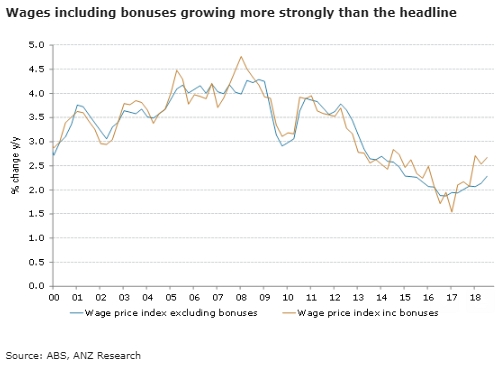Australia’s wage price index for the third quarter of this year rose to its highest in three years, while the AUD/USD currency traded range-bound at the time of writing during Asian session Tuesday. Further inroads into unemployment and underemployment are necessary preconditions for a more meaningful uplift in wages, according to the latest report from ANZ Research.
The wage price index (WPI) rose by 0.6 percent q/q and 2.3 percent y/y in Q3, in line with market expectations but a bit softer than we expected, given the recent increase to the minimum wage. Public and private sector wage growth both rounded to 0.6 percent q/q, but in annual terms public sector wages pulled ahead to 2.5 percent y/y versus 2.1 percent y/y for the private sector.
Across industries, miners continue to experience the (equal) weakest wage growth at 1.8 percent y/y, although this accelerated from the previous quarter (1.3 percent y/y). Retail wages were also only up 1.8 percent y/y, though this was also an acceleration (from 1.5 percent y/y).
Wage growth accelerated in most sectors, with construction the only one to show a (modest) slowdown. Wages are growing fastest in health (2.8 percent y/y), education (2.7 percent y/y) and utilities (2.7 percent y/y) and are slowest in mining and retail (1.8 percent y/y), rental & real estate (1.9 percent y/y) and construction (1.9 percent y/y).
Across the states, wages in Western Australia (+1.6 percent y/y) and the Northern Territory (+1.7 percent y/y) remain the weakest, though they are picking up. Tasmanian workers are still enjoying stronger wage rises than their mainland counterparts (+2.6 percent y/y), with especially solid growth in private sector wages (+2.8 percent y/y).
Meanwhile, public sector employees in Victoria continue to enjoy the strongest wage gains (+3.3 percent y/y). At the time of writing, AUD/USD traded 0.03 percent lower at 0.7216.



 How India’s economy has fared under ten years of Narendra Modi
How India’s economy has fared under ten years of Narendra Modi  ‘They don’t have enough’ – schools in England are running food banks for families
‘They don’t have enough’ – schools in England are running food banks for families  How cuts to marginal income tax could boost the UK’s stagnant economic growth
How cuts to marginal income tax could boost the UK’s stagnant economic growth  The idea that US interest rates will stay higher for longer is probably wrong
The idea that US interest rates will stay higher for longer is probably wrong  Why is toddler milk so popular? Follow the money
Why is toddler milk so popular? Follow the money  Digital trade protocol for Africa: why it matters, what’s in it and what’s still missing
Digital trade protocol for Africa: why it matters, what’s in it and what’s still missing  EU enlargement: What does the future hold?
EU enlargement: What does the future hold?  Mentorship is key to improving social and economic outcomes for Black youth
Mentorship is key to improving social and economic outcomes for Black youth  Industrialisation is still vital to economic development but some countries are struggling to reap its benefits
Industrialisation is still vital to economic development but some countries are struggling to reap its benefits  Food prices will climb everywhere as temperatures rise due to climate change – new research
Food prices will climb everywhere as temperatures rise due to climate change – new research 






























